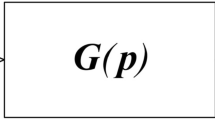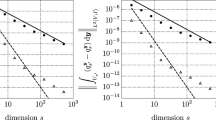Abstract
A new method for computing the optimal control, i.e., minimizing a given performance index, thereby steering the given initial state of a system to some point in the state space which may or may not be specified, is proposed here. The classical Calculus of Variations approach and the modern approach of variation in control that leads to Pontriagin’s principle have been first compared. Moreover, based on the ideas in the derivation of the Maximum Principle of Pontryagin, we have derived the maximum principle of Pontryagin using the approach of Classical Calculus of Variations modified along the line of brief perturbation and derived an expression for the change in the value of performance index over each discretized interval. First, we derived an expression for the difference in the performance index due to perturbation in control \(\mathbf{u}\) that differs slightly from \({\boldsymbol{u}}^{\boldsymbol{*}}\). Then, using the calculus of variations once again, we derived the formula for calculating the difference in the performance index using the brief perturbation suggested by Agashe. Also, we have given three examples of linear and non-linear systems for establishing the expediency of our derivations. Two examples are on the calculus of variations using the perturbation approach and one based on the derivation of Pontryagin’s principle.





Similar content being viewed by others
References
Agashe SD (1967) Some generalizations in system theory and their applications to control systems”, Ph.D. Thesis, Coordinated Science Laboratory, University of Illinois -Urbana, Report R-356
Boltianskii VG (1958) The maximum principle in the theory of optimal processes”, Reports of the Academy of Sciences, USSR, 119(6): 1079–1073, USSR
Boltianskii VG, Gamkrelidze RV and Pontryagin LS (1956) Toward the theory of optimal processes, Report of the Academy of Sciences USSR, 11(1): 7-10
Brandt-Pollmann U et al (2008) Numerical solution of optimal control problems with constant control dealys. Comput Econ 31:181–206
Butkovaskii AG (1961a) Optimal processes in distributed parameter systems. Autom Remote Control 22(1):17–26
Butkovaskii AG (1961b) The maximum principle for optimal systems with distributed parameter systems. Autom Remote Control 22(10):1288–1301
Chang DE (2009) A short proof of the Pontryagin’s maximum principle on manifolds
Chang SSL (1961) Synthesis of Optimum Control Systems, New York University, Mc-Graw Hill Book Co., Inc., New York
Desoer CA (1961) Pontryagin’s maximum principle and the principle of optimality. J Franklin Institute 271(5):361–367
Fel’dbaum AA (1965) Optimal control systems. Academic Press, New York (Translated by Kraiman A.)
Fel’dbaum AA (1953) Toward the question of the synthesis of optimal automatic control systems”, Transaction of the 2nd All-Union Conference on Automatic Control Theory, Moscow, Academy of Sciences USSR, pp. 325–360
Gamkrelidze RV (1958) Toward the general theory of optimal processes, Reports of the Academy of Sciences USSR, 123(2): 223-226
Gamkrelidze RV (1959) “Theory of processes which are optimal in speed of response in linear systems”, News of the Academy of Sciences USSR. Math Series 22(4):449–474
Gamkrelidze RV (1959) Processes which are optimal in speed of response with bounded phase coordinates, Reports of the Academy of Sciences USSR, 125(3): 475-478
Garg D et al (2010) A unified framework for the numerical solution of optimal control problems using pseudospectral methods. Automatica 40:1851
Hua H (2000) “Short communication-numerical solution of optimal control problems”, optimal control applications and methods optimal. Control Appl Meth 21:233–241
Kirk DE (1970) Optimal control theory—an introduction englewood cliffs, New Jersey, pp. 338–343
Pontryagin LS (1959) Optimal control processes. Prog Math Sci 14(1):3–20
Pontryagin LS, Boltianskii VG, Gamkrelidze RV, Mischenko EF (1962) Mathematical theory of optimal processes. Interscience Publishers, New York (Translated)
Pontryagin LS, Boltianskii VG, Gamkrelidze RV, Mischenko EF (1964) The mathematical theory of optimal processes. Permagon Press, Oxford (Translated by Brown D.E.)
Rozoner LI (1959) On the Sufficient Conditions of Optimality”, Reports of the Academy of Sciences USSR, vol.127, N0. 3, pp. 520–523
Rozoner LI (1959b) The maximum principle of Pontryagin L.S. in the theory of optimal systems. Autom Remote Control 20(101):1320–1334
Rozoner LI (1960) On the Variational Methods of Investigating the Quality of automatic Control Systems”, In Automatic and Remote Control, vol. 4, pp. 1621–1624, Butterworth’s Scientific Publications, London
Von Stryk O (1993) Numerical solution of optimal control problems by direct collocation. In: Bullirsch R, Miele A, Stoer J, Well KH (eds) Optimal control—calculus of variations optimal control theory and numerical methods. Birkhäuser Basel, pp 129–143
Author information
Authors and Affiliations
Contributions
SDA, BKL, FA were involved in conceptualization; VJ, GC contributed to methodology; VJ, GC were involved in formal analysis and investigation, writing—original draft preparation; SDA, BKL, FA contributed to writing—review and editing, supervision.
Corresponding author
Ethics declarations
Conflict of interest
The authors declare that they have no conflict of interest.
Ethical approval
This article does not contain any studies with human participants or animals performed by any of the authors.
Additional information
Communicated by Vicente Garcia Diaz.
Publisher's Note
Springer Nature remains neutral with regard to jurisdictional claims in published maps and institutional affiliations.
Rights and permissions
About this article
Cite this article
Agashe, S.D., Lande, B.K., Jain, V. et al. Numerical solution of optimal control problem. Soft Comput 27, 3389–3401 (2023). https://doi.org/10.1007/s00500-021-06019-2
Accepted:
Published:
Issue Date:
DOI: https://doi.org/10.1007/s00500-021-06019-2




